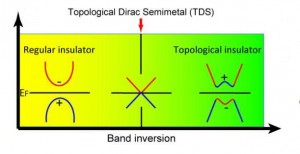From the Lawrence Berkeley National Laboratory:
Natural 3D Counterpart to Graphene Discovered
Researchers at Berkeley Lab’s Advanced Light Source Find New Form of Quantum Matter
The discovery of what is essentially a 3D version of graphene – the 2D sheets of carbon through which electrons race at many times the speed at which they move through silicon – promises exciting new things to come for the high-tech industry, including much faster transistors and far more compact hard drives. A collaboration of researchers at the U.S Department of Energy (DOE)’s Lawrence Berkeley National Laboratory (Berkeley Lab) has discovered that sodium bismuthide can exist as a form of quantum matter called a three-dimensional topological Dirac semi-metal (3DTDS). This is the first experimental confirmation of 3D Dirac fermions in the interior or bulk of a material, a novel state that was only recently proposed by theorists.A topological Dirac semi-metal state is realized at the critical point in the phase transition from a normal insulator to a topological insulator. The + and – signs denote the even and odd parity of the energy bands.
“A 3DTDS is a natural three-dimensional counterpart to graphene with similar or even better electron mobility and velocity,” says Yulin Chen, a physicist from the University of Oxford who led this study working with Berkeley Lab’s Advanced Light Source (ALS) . “Because of its 3D Dirac fermions in the bulk, a 3DTDS also features intriguing non-saturating linear magnetoresistance that can be orders of magnitude higher than the materials now used in hard drives, and it opens the door to more efficient optical sensors."....MORE
